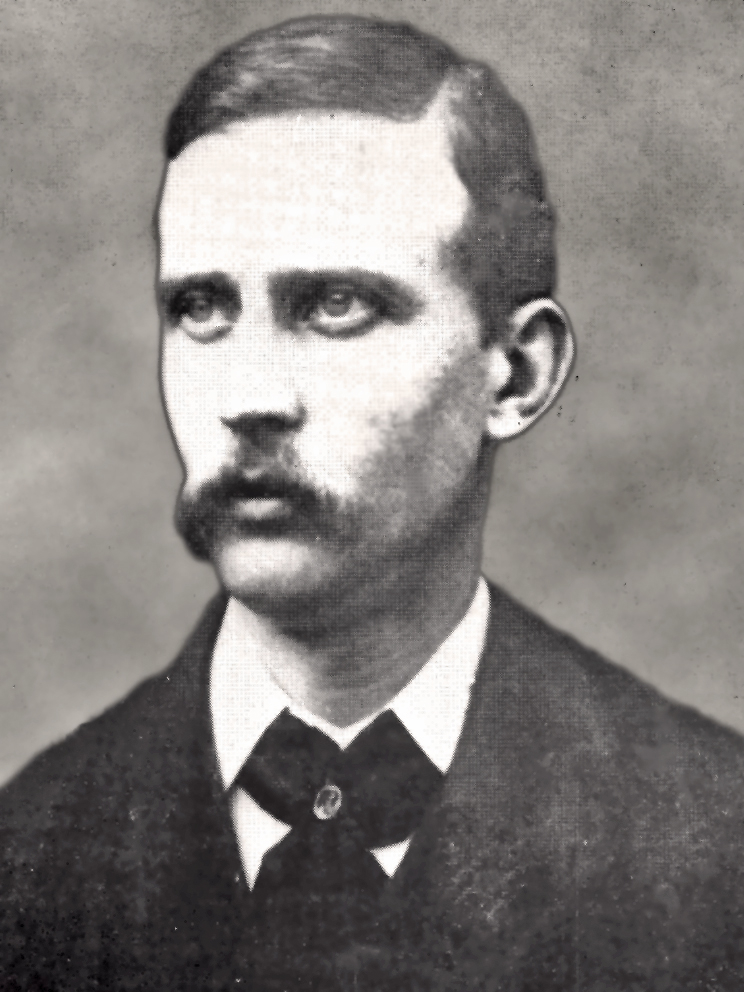|
H. Newell Martin
Henry Newell Martin, FRS (1 July 1848 – 27 October 1896) was a British physiologist and vivisection activist. Biography He was born in Newry, County Down, the son of Henry Martin, a Congregational minister. He was educated at University College, London and Christ's College, Cambridge, where he matriculated in 1870, took the Part I Natural Sciences in 1873, and graduated B.A. in 1874. At the University of London, where he had graduated B.Sc. in 1870, he went on to become M.B. in 1871, and D.Sc. in 1872. Martin worked as demonstrator to Michael Foster of Trinity College from 1870 to 1876; and was a Fellow of Christ's College for five years from 1874. Daniel Coit Gilman of Johns Hopkins University, on advice from Foster and Thomas Huxley, hired Martin in 1876 and set up the university's Biology Department around him. Martin was appointed to the university's first professorship of physiology, one of the first five full professors appointed to the Hopkins faculty. It was under ... [...More Info...] [...Related Items...] OR: [Wikipedia] [Google] [Baidu] |
Burley-in-Wharfedale
Burley in Wharfedale is a village and civil parish within the City of Bradford in West Yorkshire, England, in the Wharfedale valley. In 2011, it had a population of 7,041. The village is on the A65 road, north-west from Leeds, north from Bradford, from Ilkley and from Otley. The hamlet of Burley Woodhead at the foot of Rombalds Moor, Burley Moor is to the south-west. Etymology The name of Burley in Wharfedale is first attested in an eleventh-century copy of a charter issued in 972, as ''Burhleg''. It appears in the Domesday Book of 1086 in the spellings ''Burgelei'', ''Burgelay'', ''Burghelai'', and ''Burghelay''. The comes from the Old English words ''burg'' ('fortification') and ''lēah'' ('open land in a wood'), and thus meant 'open land in a wood, characterised by a fortification'. The specification 'in Wharfedale', deployed to avoid ambiguity with the Burley (other), various other English places of the same name, is first attested during the reign of Edward ... [...More Info...] [...Related Items...] OR: [Wikipedia] [Google] [Baidu] |
Johns Hopkins University Press
Johns Hopkins University Press (also referred to as JHU Press or JHUP) is the publishing division of Johns Hopkins University. It was founded in 1878 and is the oldest continuously running university press in the United States. The press publishes books and journals, and operates other divisions including fulfillment and electronic databases. Its headquarters are in Charles Village section of Baltimore, Maryland Maryland ( ) is a U.S. state, state in the Mid-Atlantic (United States), Mid-Atlantic region of the United States. It borders the states of Virginia to its south, West Virginia to its west, Pennsylvania to its north, and Delaware to its east .... In 2017, after the retirement of Kathleen Keane, who is credited with modernizing JHU Press for the digital age, the university appointed new director Barbara Pope. Overview Daniel Coit Gilman, the first president of Johns Hopkins University, inaugurated the press in 1878. The press began as the university's Public ... [...More Info...] [...Related Items...] OR: [Wikipedia] [Google] [Baidu] |
Medical Record (journal)
''The Medical Record: A Weekly Journal of Medicine and Surgery'' was an American medical journal founded in 1866 by George Frederick Shrady, Sr., who was its first editor-in-chief. Thomas Lathrop Stedman became assistant editor in 1890 and editor-in-chief in 1897. It was published in New York City. It was later published by the Washington Institute of Medicine. Many issues of ''Medical Record'' are now in the public domain and available through the Google Books Google Books (previously known as Google Book Search, Google Print, and by its code-name Project Ocean) is a service from Google that searches the full text of books and magazines that Google has scanned, converted to text using optical charac ... project. References Academic journals established in 1866 General medical journals 1866 establishments in New York (state) {{general-medical-journal-stub ... [...More Info...] [...Related Items...] OR: [Wikipedia] [Google] [Baidu] |
Popular Science
Popular science (also called pop-science or popsci) is an interpretation of science intended for a general audience. While science journalism focuses on recent scientific developments, popular science is more broad ranging. It may be written by professional science journalists or by scientists themselves. It is presented in many forms, including books, film and television documentaries, magazine articles, and web pages. History Before the modern specialization and professionalization of science, there was often little distinction between "science" and "popular science", and works intended to share scientific knowledge with a general reader existed as far back as Greek and Roman antiquity. Without these popular works, much of the scientific knowledge of the era might have been lost. For example, none of the original works of the Greek astronomer Eudoxus (4th century BC) have survived, but his contributions were largely preserved due to the didactic poem '' Phenomena'' writte ... [...More Info...] [...Related Items...] OR: [Wikipedia] [Google] [Baidu] |
Macmillan Publishers
Macmillan Publishers (occasionally known as the Macmillan Group; formally Macmillan Publishers Ltd in the United Kingdom and Macmillan Publishing Group, LLC in the United States) is a British publishing company traditionally considered to be one of the Big Five (publishers), "Big Five" English language publishers (along with Penguin Random House, Hachette Book Group USA, Hachette, HarperCollins and Simon & Schuster). Founded in London in 1843 by Scottish brothers Daniel MacMillan, Daniel and Alexander MacMillan (publisher), Alexander MacMillan, the firm soon established itself as a leading publisher in Britain. It published two of the best-known works of Victorian-era children's literature, Lewis Carroll's ''Alice's Adventures in Wonderland'' (1865) and Rudyard Kipling's ''The Jungle Book'' (1894). Former Prime Minister of the United Kingdom, Harold Macmillan, grandson of co-founder Daniel, was chairman of the company from 1964 until his death in December 1986. Since 1999, Macmi ... [...More Info...] [...Related Items...] OR: [Wikipedia] [Google] [Baidu] |
Journal Of Anatomy And Physiology
A journal, from the Old French ''journal'' (meaning "daily"), may refer to: *Bullet journal, a method of personal organization *Diary, a record of personal secretive thoughts and as open book to personal therapy or used to feel connected to oneself. A record of what happened over the course of a day or other period *Daybook, also known as a general journal, a daily record of financial transactions *Logbook, a record of events important to the operation of a vehicle, facility, or otherwise *Transaction log, a chronological record of data processing *Travel journal, a record of the traveller's experience during the course of their journey In publishing, ''journal'' can refer to various periodicals or serials: *Academic journal, an academic or scholarly periodical **Scientific journal, an academic journal focusing on science **Medical journal, an academic journal focusing on medicine **Law review, a professional journal focusing on legal interpretation *Magazine, non-academic or scho ... [...More Info...] [...Related Items...] OR: [Wikipedia] [Google] [Baidu] |
Hugh Hawkins
Hugh Dodge Hawkins (September 3, 1929 – May 6, 2016) was an American historian. A 1961 Guggenheim Fellow, he wrote three books on university history: ''Pioneer: A History of the Johns Hopkins University'' (1960), ''Between Harvard and America'' (1972), and ''Banding Together'' (1992). He spent more than four decades as a professor at Amherst College, where he became Anson D. Morse Professor of History and American Studies. After her retirement, he wrote two memoirs and a semi-autobiographical short story collection. Biography Hugh Dodge Hawkins was born on September 3, 1929, in Topeka, Kansas, the youngest of five children of Rowena ( Eddy) and James Hawkins. The family moved frequently due to his father's job as a dispatcher for Chicago, Rock Island and Pacific Railroad, before moving to El Reno, Oklahoma, where he graduated from high school. After attending Washburn College, he transferred after one semester to DePauw University, where he obtained his BA in 1950. In 1954, he ... [...More Info...] [...Related Items...] OR: [Wikipedia] [Google] [Baidu] |
Theory Of Evolution
Evolution is the change in the heritable characteristics of biological populations over successive generations. It occurs when evolutionary processes such as natural selection and genetic drift act on genetic variation, resulting in certain characteristics becoming more or less common within a population over successive generations. The process of evolution has given rise to biodiversity at every level of biological organisation. The scientific theory of evolution by natural selection was conceived independently by two British naturalists, Charles Darwin and Alfred Russel Wallace, in the mid-19th century as an explanation for why organisms are adapted to their physical and biological environments. The theory was first set out in detail in Darwin's book ''On the Origin of Species''. Evolution by natural selection is established by observable facts about living organisms: (1) more offspring are often produced than can possibly survive; (2) traits vary among individuals with ... [...More Info...] [...Related Items...] OR: [Wikipedia] [Google] [Baidu] |
Bahamas
The Bahamas, officially the Commonwealth of The Bahamas, is an archipelagic and island country within the Lucayan Archipelago of the Atlantic Ocean. It contains 97 per cent of the archipelago's land area and 88 per cent of its population. It comprises more than 3,000 islands, cays and islets in the Atlantic Ocean, and is located north of Cuba and north-west of the island of Hispaniola (split between the Dominican Republic and Haiti) and the Turks and Caicos Islands, southeast of the U.S. state of Florida and east of the Florida Keys. The capital and largest city is Nassau on the island of New Providence. The Royal Bahamas Defence Force describes the Bahamas' territory as encompassing of ocean space. The Bahama islands were inhabited by the Arawak and Lucayans, a branch of the Arawakan- speaking Taíno, for many centuries. Christopher Columbus was the first European to see the islands, making his first landfall in the "New World" in 1492 when he landed on the ... [...More Info...] [...Related Items...] OR: [Wikipedia] [Google] [Baidu] |
Beaufort, North Carolina
Beaufort ( , different from that of Beaufort, South Carolina) is a town in Carteret County, North Carolina, United States, and its county seat. Established in 1713 and incorporated in 1723, Beaufort is the fourth oldest town in North Carolina (after Bath, North Carolina, Bath, New Bern, North Carolina, New Bern and Edenton, North Carolina, Edenton). The population was 4,464 at the 2020 United States census, 2020 census. Beaufort is located in North Carolina's "Inner Banks" region. The town is home to the North Carolina Maritime Museum, the Duke University Marine Laboratory (Nicholas School of the Environment), and the National Oceanic and Atmospheric Administration (NOAA) Center for Coastal Fisheries and Habitat Research. It is also the location of the Rachel Carson Reserve, part of the N.C. Coastal Reserve and National Estuarine Research Reserve system. It is sometimes confused with Beaufort, South Carolina, a city of the same name in South Carolina; the two are distinguished b ... [...More Info...] [...Related Items...] OR: [Wikipedia] [Google] [Baidu] |
Chesapeake Zoological Laboratory
William Keith Brooks (March 25, 1848 – November 12, 1908) was an American zoologist, born in Cleveland, Ohio, March 25, 1848. Brooks studied embryological development in invertebrates and founded a marine biological laboratory where he and others studied heredity. His best known book, ''The Oyster'', was first published in 1891 and has been reprinted many times. Brooks was proficient in many subjects, including Greek and biology, and as a young man was unsure where he wished to focus his studies. He spent two years at Hobart College before settling on biology, and then transferred to Williams College, where he received his BA in 1870. He then entered Harvard and studied under Louis Agassiz, receiving his PhD in 1875. A year later he became a junior faculty member at Johns Hopkins University when it opened, teaching and researching marine biology. After marrying Amelia Katherine Schultz in 1878, Brooks founded the Chesapeake Zoological Laboratory. He spent most summers at ... [...More Info...] [...Related Items...] OR: [Wikipedia] [Google] [Baidu] |





